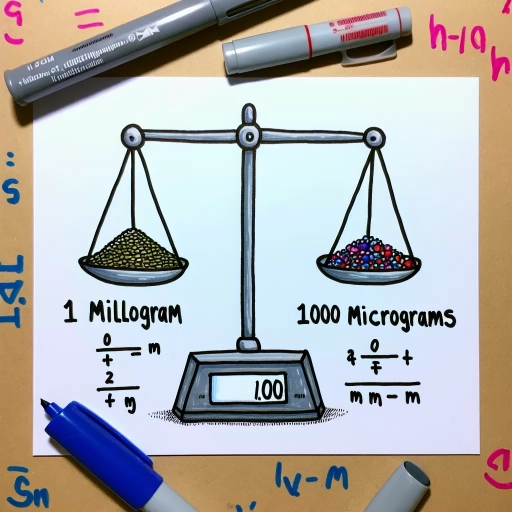How Many Micrograms In A Milligram

Understanding the Basic Units of Measurement
The Concept of Micrograms and Milligrams
A microgram is a unit of weight used in the metric system, and it is equivalent to 1/1,000,000th of a gram. The prefix 'micro' stems from the Greek word 'mikros,' meaning small. On the other hand, a milligram is 1/1,000th of a gram. The prefix 'milli' is derived from the Latin word 'mille,' which means one thousand. In comparing the two units, it's apparent that a milligram is larger than a microgram, but just how much larger poses the core question of our article.
Relationship Between Micrograms and Milligrams
The relationship between micrograms (mcg) and milligrams (mg) is rooted in the fundamentals of the metric system. The metric system operates on tens, so each unit is 10, 100, or 1,000 times larger or smaller than the neighboring unit. A milligram is 1,000 times larger than a microgram, indicating that a single milligram is equivalent to 1,000 micrograms. This difference is important and needs to be precise, especially in disciplines such as medicine where dosage accuracy is critical.
Calculating and Converting Micrograms to Milligrams
Conversion between units is fairly straightforward thanks to standard conversion ratios used in the metric system. As stated above, if you have a measurement in milligrams and you want to express it in micrograms, you multiply by 1,000. Conversely, if you have a measurement in micrograms and want to express it in milligrams, divide by 1,000. It's worth noting that such conversions are crucial in numerous sectors, including scientific experiments, medical applications, and nutritional information labeling.
Practical Applications of Micrograms and Milligrams
Medical and Clinical Usage
In the world of medicine, the difference between micrograms and milligrams is critical. Given the potent nature of many medications, a minor error in dosage measurement could lead to severe consequences, including therapeutic failure or toxicity. For instance, drug ingredients are often measured in minuscule amounts, requiring the smaller unit of microgram. On the other hand, some dietary supplements like vitamins are often measured in larger amounts, hence the use of milligrams. Thus, health professionals and patients alike must understand the conversion ratios between the two to ensure correct dosages are administered.
Scientific Research and Analysis
Scientists also often work with micrograms and milligrams, particularly in fields like chemistry and biochemistry. The scales of their experiments might require them to deal with very small quantities, so the ability to accurately measure and convert between these units is vital. For instance, in a biochemical experiment, enzymes or other biomolecules' measurements are often given in micrograms or milligrams. The ability to convert accurately between these units could be the difference between a successful experiment and a failed one.
Nutrition and Dietary Understanding
Micrograms and milligrams are both commonly used units in nutrition labeling. Knowing how to convert between them is essential for anyone wanting to monitor their dietary intake accurately. Nutrients such as vitamins and minerals are typically measured in these units. For instance, the recommended dietary allowance (RDA) for Vitamin C for adults is 75 milligrams for women and 90 milligrams for men. Meanwhile, the RDA for Vitamin B12 for adults is 2.4 micrograms. Being able to understand and convert these measurements enables consumers to make better-informed decisions about their diet.
Ensuring Accuracy in Conversion
The Importance of Precision
Accuracy in conversion between micrograms and milligrams is paramount in several applications. As the difference between these units can be substantial in certain contexts, ensuring precision in conversion can significantly affect the outcome of various endeavors, from scientific experiments to medical dosages to nutritional intakes. It's also worth noting that accuracy helps avoid potential confusion or error, especially in the metric system, where many units of measurement bear close resemblance.
Tools for Conversion
To aid in accurate conversions, numerous online calculators and mobile apps can convert between micrograms and milligrams. These tools use standardized conversion ratios to ensure reliable results. It can be beneficial to use these tools, especially in contexts where precision is crucial. Furthermore, these digital converters can provide immediate results, saving time and ensuring efficiency in conversion tasks.
Common Mistakes in Conversion
While conversion between micrograms and milligrams is fundamentally simple, mistakes can still happen. One common error is confusion between units, leading to incorrect conversion operations. Another frequently seen mistake is misplacement of decimal points. Since milligrams are a larger unit, misplacing a decimal point could result in a significant discrepancy. Therefore, understanding the magnitude difference between these units and practicing careful calculations are crucial to prevent potential errors.